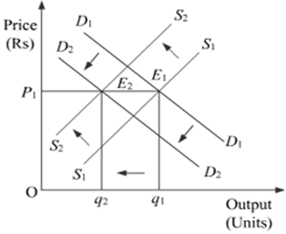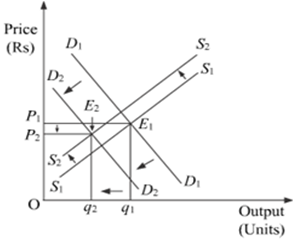Market for a good is in equilibrium. There is simultaneous decrease both in demand and supply of the good. Explain its effect on market price.
The simultaneous decrease in demand and supply affects the equilibrium price and output depending on the magnitude of the change in demand and supply. The simultaneous decrease in the demand and supply can be bifurcated into the following three conditions.
i. When Demand and Supply Decrease in the Same Proportion
Let S1 and D1 be the initial supply curve and the initial demand curve respectively. The initial equilibrium is at point E1, with equilibrium price at P1 and equilibrium output Q1.
Suppose that both demand and supply decrease by the same proportion. Consequently, the demand curve shifts to D2 and the supply curve shifts to S2. The new equilibrium is at point at E2 with lower equilibrium output Q2 but the same equilibrium price P1. Thus, when both demand and supply decrease in the same proportion, the equilibrium price remains the same, but the equilibrium quantity falls.
ii. When Demand Decreases more than the Decrease in Supply
Let D1 and S1 be the initial demand curve and the initial supply curve, respectively. The initial equilibrium is at point E1 with equilibrium price P1 and equilibrium output Q1.
Now let us suppose that demand decrease to D2 and supply decreases by lesser proportion to S2. Consequently, the new equilibrium is established at point E2. At the new equilibrium, the equilibrium price falls to P2 and equilibrium output falls to Q2. Thus, when decrease in demand is more than the decrease in supply, the equilibrium price falls accompanied by the fall in equilibrium output.
iii. When Decrease in Demand is lesser than Decrease in Supply.
Let the initial equilibrium be at point E1, determined by the intersection of the initial demand curve D1 and the initial supply curve S1. The equilibrium price is P1 and the equilibrium output is Q1.
Now suppose that the demand decreases but lesser than the decrease in the supply. The demand curve shifts to D2 while the supply curve shifts to S2. The new equilibrium determined by the intersection of D2 and S2 is at point E2, where the equilibrium price increases to P2 and the equilibrium quantity falls to Q2. Thus, when decrease in demand is lesser than the decrease in supply then the equilibrium price rises and equilibrium output falls to Q2.





